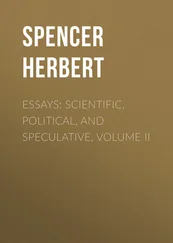It remains only to point out that while the genesis of the Solar System, and of countless other systems like it, is thus rendered comprehensible, the ultimate mystery continues as great as ever. The problem of existence is not solved: it is simply removed further back. The Nebular Hypothesis throws no light on the origin of diffused matter; and diffused matter as much needs accounting for as concrete matter. The genesis of an atom is not easier to conceive than the genesis of a planet. Nay, indeed, so far from making the Universe less a mystery than before, it makes it a greater mystery. Creation by manufacture is a much lower thing than creation by evolution. A man can put together a machine; but he cannot make a machine develop itself. That our harmonious universe once existed potentially as formless diffused matter, and has slowly grown into its present organized state, is a far more astonishing fact than would have been its formation after the artificial method vulgarly supposed. Those who hold it legitimate to argue from phenomena to noumena, may rightly contend that the Nebular Hypothesis implies a First Cause as much transcending "the mechanical God of Paley," as this does the fetish of the savage.
[11] Cosmos. (Seventh Edition.) Vol. i. pp. 79, 80.
[12]Since the publication of this essay the late Mr. R. A. Proctor has given various further reasons for the conclusion that the nebulæ belong to our own sidereal system. The opposite conclusion, contested throughout the foregoing section, has now been tacitly abandoned.
[13]Any objection made to the extreme tenuity this involves, is met by the calculation of Newton, who proved that were a spherical inch of air removed four thousand miles from the Earth, it would expand into a sphere more than filling the orbit of Saturn.
[14]A reference may fitly be made here to a reason given by Mons. Babinet for rejection of the Nebular Hypothesis. He has calculated that taking the existing Sun, with its observed angular velocity, its substance, if expanded so as to fill the orbit of Neptune, would have nothing approaching the angular velocity which the time of revolution of that planet implies. The assumption he makes is inadmissible. He supposes that all parts of the nebulous spheroid when it filled Neptune's orbit, had the same angular velocities. But the process of nebular condensation as indicated above, implies that the remoter flocculi of nebulous matter, later in reaching the central mass, and forming its peripheral portions, will acquire, during their longer journeys towards it, greater velocities. An inspection of one of the spiral nebulæ, as 51st or 99th Messier, at once shows that the outlying portions when they reach the nucleus, will form an equatorial belt moving round the common centre more rapidly than the rest. Thus the central parts will have small angular velocities, while there will be increasing angular velocities of parts increasingly remote from the centre. And while the density of the spheroid continues small, fluid friction will scarcely at all change these differences.
A like criticism may, I think, be passed on an opinion expressed by Prof. Newcomb. He says:—"When the contraction [of the nebulous spheroid] had gone so far that the centrifugal and attracting forces nearly balanced each other at the outer equatorial limit of the mass, the result would have been that contraction in the direction of the equator would cease entirely, and be confined to the polar regions, each particle dropping, not towards the sun, but towards the plane of the solar equator. Thus, we should have a constant flattening of the spheroidal atmosphere until it was reduced to a thin flat disk. This disk might then separate itself into rings, which would form planets in much the same way that Laplace supposed. But there would probably be no marked difference in the age of the planets." ( Popular Astronomy , p. 512.) Now this conclusion assumes, like that of M. Babinet, that all parts of the nebulous spheroid had equal angular velocities. If, as above contended, it is inferable from the process by which a nebulous spheroid was formed, that its outer portions revolved with greater angular velocities than its inner; then the inference which Prof. Newcomb draws is not necessitated.
[15]It is true that since this essay was written reasons have been given for concluding that comets consist of swarms of meteors enveloped in aeriform matter. Very possibly this is the constitution of the periodic comets which, approximating their orbits to the plane of the Solar System, form established parts of the System, and which, as will be hereafter indicated, have probably a quite different origin.
[16]Though this rule fails at the periphery of the Solar System, yet it fails only where the axis of rotation, instead of being almost perpendicular to the orbit-plane, is very little inclined to it; and where, therefore, the forces tending to produce the congruity of motions were but little operative.
[17]It is true that, as expressed by him, these propositions of Laplace are not all beyond dispute. An astronomer of the highest authority, who has favoured me with some criticisms on this essay, alleges that instead of a nebulous ring rupturing at one point, and collapsing into a single mass, "all probability would be in favour of its breaking up into many masses." This alternative result certainly seems the more likely. But granting that a nebulous ring would break up into many masses, it may still be contended that, since the chances are infinity to one against these being of equal sizes and equidistant, they could not remain evenly distributed round their orbit. This annular chain of gaseous masses would break up into groups of masses; these groups would eventually aggregate into larger groups; and the final result would be the formation of a single mass. I have put the question to an astronomer scarcely second in authority to the one above referred to, and he agrees that this would probably be the process.
[18]The comparative statement here given differs, slightly in most cases and in one case largely, from the statement included in this essay as originally published in 1858. As then given the table ran thus:—
| Mercury. |
Venus. |
Earth. |
Mars. |
Jupiter. |
Saturn. |
Uranus. |
| 1⁄ 362 |
1⁄ 282 |
1⁄ 289 |
1⁄ 326 |
1⁄ 14 |
1⁄ 6·2 |
1⁄ 9 |
|
|
1 Satellite. |
|
4 Satellites. |
8 Satellites, and three rings |
4 (or 6 according to Herschel). |
The calculations ending with these figures were made while the Sun's distance was still estimated at 95 millions of miles. Of course the reduction afterwards established in the estimated distance, entailing, as it did, changes in the factors which entered into the calculations, affected the results; and, though it was unlikely that the relations stated would be materially changed, it was needful to have the calculations made afresh. Mr. Lynn has been good enough to undertake this task, and the figures given in the text are his. In the case of Mars a large error in my calculation had arisen from accepting Arago's statement of his density (0·95), which proves to be something like double what it should be. Here a curious incident may be named. When, in 1877, it was discovered that Mars has two satellites, though, according to my hypothesis, it seemed that he should have none, my faith in it received a shock; and since that time I have occasionally considered whether the fact is in any way reconcilable with the hypothesis. But now the proof afforded by Mr. Lynn that my calculation contained a wrong factor, disposes of the difficulty—nay, changes the objection to a verification. It turns out that, according to the hypothesis, Mars ought to have satellites; and, further, that he ought to have a number intermediate between 1 and 4.
Читать дальше












